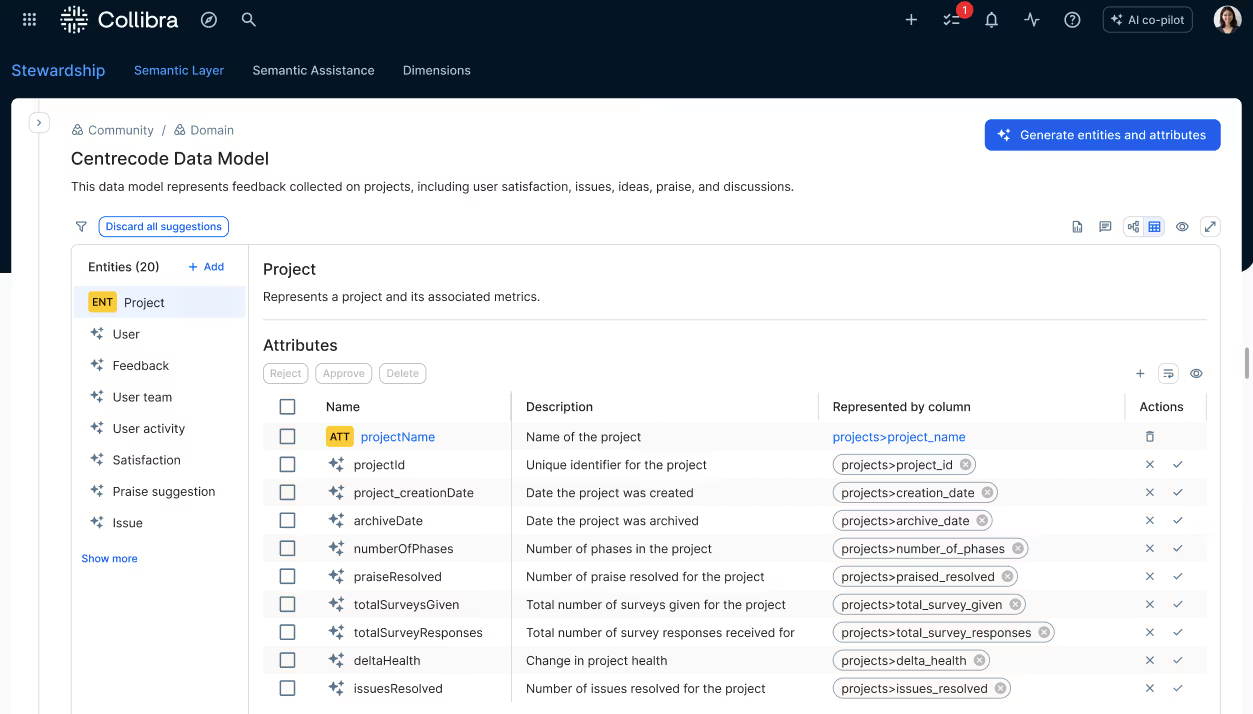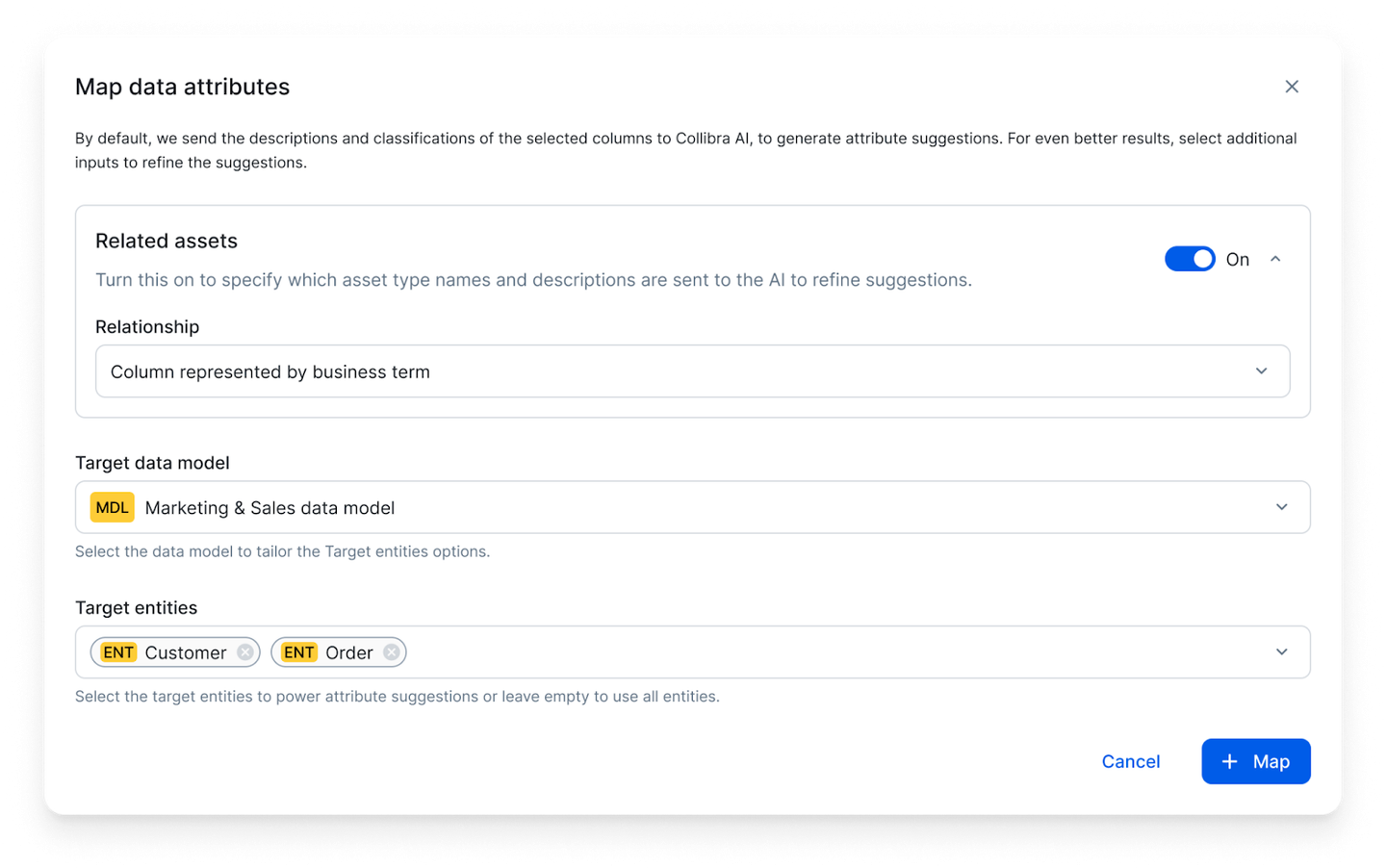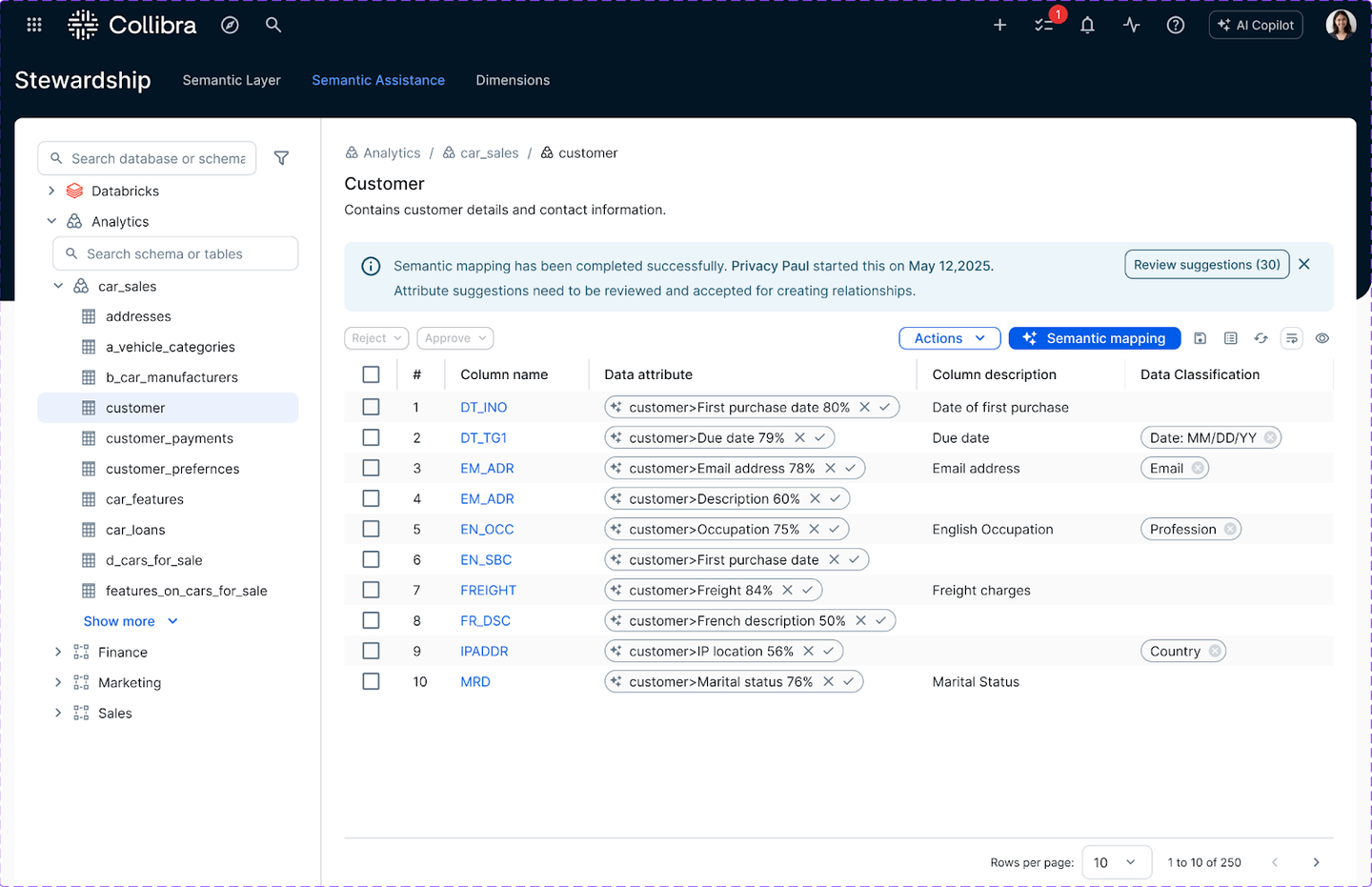Let AI do the mapping: Introducing Collibra’s semantic agents

“From a 2024 Gartner survey on the evolution of data management, 44% of the respondents in AI-ready organizations report that semantic alignment is a key factor in assessing the AI readiness of their data.” This highlights a critical challenge: while organizations know that semantic alignment is essential for AI, the actual process of creating that semantic layer has historically been a slow, manual bottleneck.
What’s new: Semantic mapping and model generation agents
The ultimate goal of any data strategy is to build a common language between your technical data and your business. The manual process of building a semantic layer has long been a primary roadblock to effective data discovery and efficient data use. Today, Collibra introduces a powerful duo of AI agents designed to automate the creation of your semantic layer.
Our new semantic model generation agent automatically creates a business-friendly model from your physical data, while the semantic mapping agent uses AI to suggest the links between technical columns and their business definitions. These powerful agents introduce AI-powered automation to dramatically simplify how you create and connect your semantic layer.
How semantic agents help
For any data-driven organization, the goal is to connect raw, technical data to its real-world business meaning. Without an efficient way to build this layer of business context, the true value of data remains locked away. This is where our new semantic agents deliver a breakthrough. The semantic model generation agent simplifies the traditionally tedious work of creating a semantic layer, while the semantic mapping agent uses AI to provide accurate, relevant suggestions to link physical assets to that new model.
Problems it solves
Previously, linking column names to clear business terms was a slow, manual, and error-prone task left to data stewards. This tedious work creates a significant bottleneck, resulting in incomplete data dictionaries that hinder data discovery, weaken governance and prevent data teams from scaling their efforts. Now, our new semantic agents solve for:
- Time-consuming manual mapping: Organizations struggle with the manual process of mapping data elements between physical data assets and their semantic representations, which is a significant drain on time
- Error-prone and outdated data dictionaries: This manual mapping process is highly susceptible to errors and often results in data dictionaries that are inaccurate or quickly become obsolete
- Difficulty in creating a semantic layer: Connecting physical data to the semantic layer is a highly manual activity that consumes significant data steward time
How semantic agents work
The semantic mapping agent and semantic model generation agent work through distinct, but complementary, AI-powered automation processes to establish and connect the semantic layer to the physical data layer.
Semantic model generation agent (Creating the semantic layer)
Our Semantic Model Generation Agent works by first analyzing your existing organizational metadata, including the terms and definitions from your business glossary and the calculation rules from your metric catalogs.
It combines this business context with the technical metadata from your physical data assets, such as table and column names. Using these inputs, the agent then automatically generates a new, business-friendly semantic layer of data entities and attributes, complete with descriptions and data classifications, and instantly establishes all the critical linkages—mapping the new attributes back to the physical columns and connecting them to the relevant business terms and KPIs.

Creation of a Model and generation of Entities and Attributes
Semantic mapping agent (connecting the semantic layer)
The semantic mapping agent simplifies the process of connecting physical data to its business meaning through an intelligent, AI-powered workflow.
The process begins when a data steward identifies the target data set. The agent then analyzes a rich set of inputs, including technical metadata (like table and column names), existing governance context (like data classification labels) and the target semantic layer.

Map data attributes by selecting the specific data model and data entities to power AI-suggestions
The agent's advanced machine learning algorithms perform the automated stitching, providing the steward with accurate and relevant suggestions for mapping physical columns to their corresponding data attributes. Once the suggestions are accepted, the agent automatically creates the linkages in the metadata graph, ensuring a complete and accurate connection from the raw data to the business terms and KPIs it represents.

End result of semantic mapping process displaying physical columns mapped to data attributes
Why you should be excited
The benefits of AI-powered semantic layer management extend across a wide range of roles:
- Data stewards: Automating the mapping process between physical and semantic assets will drastically reduce the time and effort required, allowing data stewards to focus on more strategic tasks and enabling the re-use of semantic mappings
- Analysts and business users: Accelerate insights and reduce analysis errors by working with trusted, semantically enriched data
And these AI-powered agents deliver significant value across two key technical use cases:
- Accelerating the creation of an initial semantic model: For organizations starting without a defined semantic structure, the agent simplifies the creation of a foundational semantic layer. It automatically generates business-friendly data entities and attributes, complete with descriptions and data classifications, providing a mature starting point in a fraction of the time
- Automating the connection of data assets to business context: For data stewards facing the daunting task of manually linking thousands of physical data columns to their business meaning, the agent provides AI-powered mapping suggestions. By analyzing technical metadata and existing classifications (like PII), it intelligently recommends connections to data attributes and business terms, dramatically accelerating the process required for automated lineage and compliance checks
Key takeaways about semantic agents
Collibra’s new semantic agents represent a fundamental shift in how organizations can bridge the gap between their technical data and essential business context. By leveraging AI to automate the historically manual process of semantic mapping, we are empowering data stewards to operate with a speed and scale that was previously impossible. This is "AI-powered governance, everywhere" in action, embedding intelligence directly into the foundational processes of your data program to revolutionize how you create and manage business context.
Join Collibra’s Product Premiere to learn:
- The latest platform innovations in our October release
- How to autogenerate the creation of a semantic model
- How to automate the data mapping process
Stay tuned for public preview to go live in November.
Keep up with the latest from Collibra
I would like to get updates about the latest Collibra content, events and more.
Thanks for signing up
You'll begin receiving educational materials and invitations to network with our community soon.


